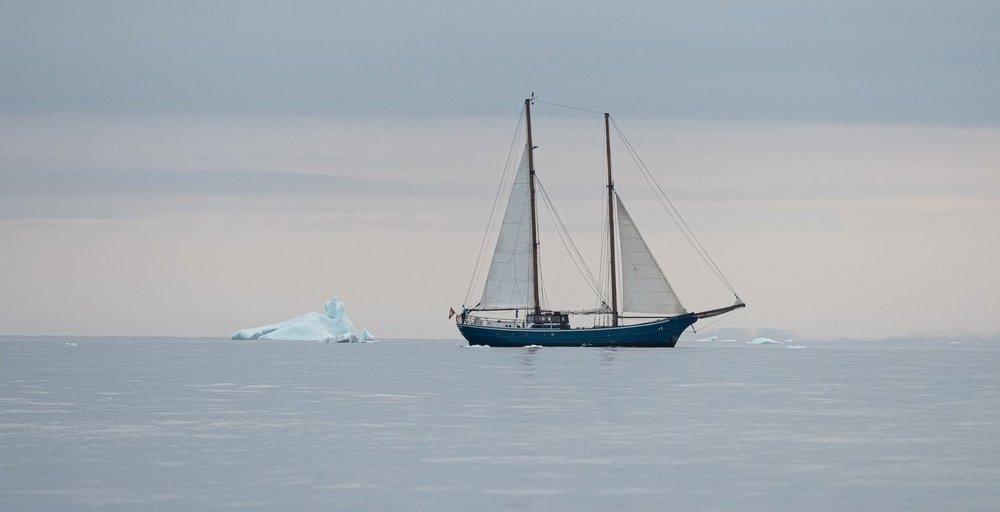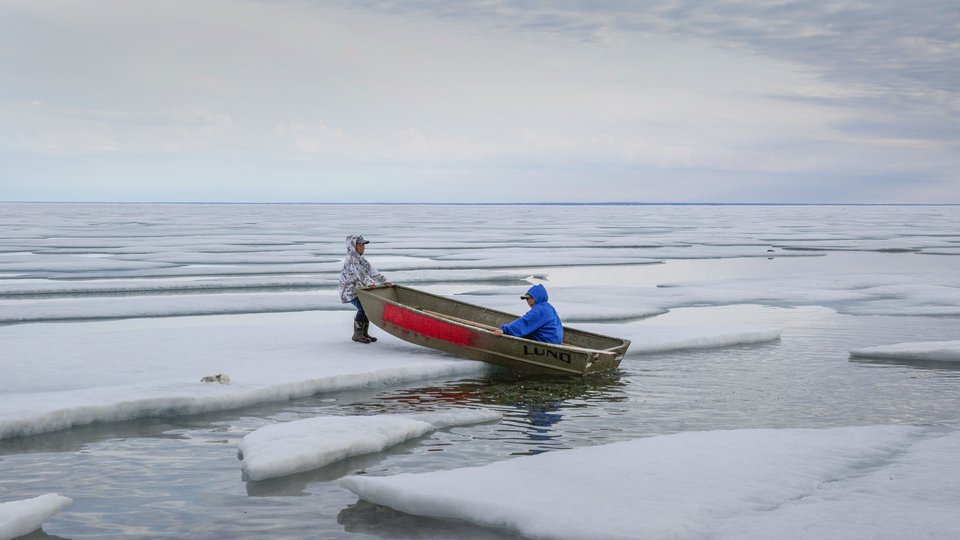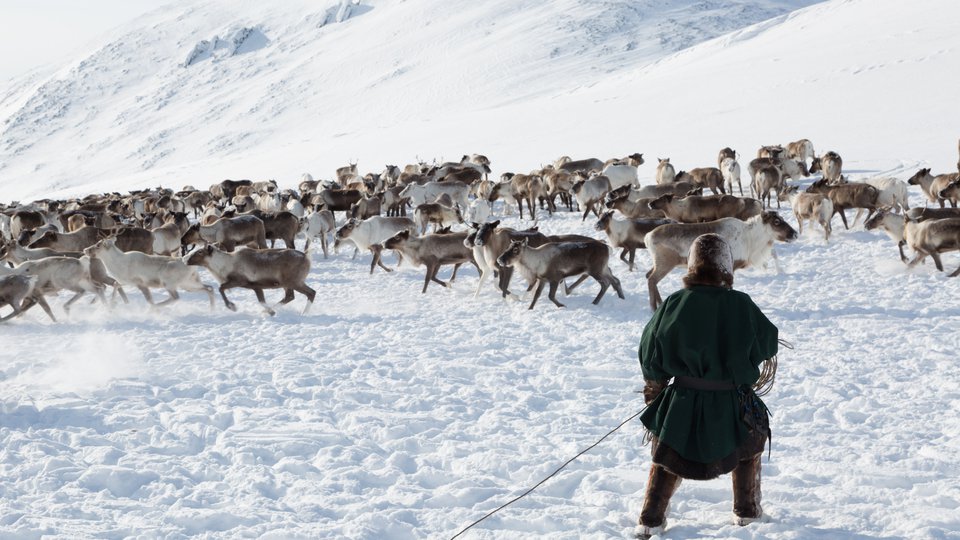
Beyond Her Horizons, a film created by Jessica Houston and Okalik Eegeesiak explores women's often-overlooked role in Arctic exploration and the contemporary impact of northern landscapes on identity and community. The film is unique not only for its focus on Indigenous knowledge and the environment but also for how it redefines narratives of discovery and connection with the land. The filmmakers spoke with Arctic Focus about the significance of their project, the stories they uncovered, and the challenges they faced along the way.
Q: What inspired you to create Beyond Her Horizons?
Jessica Houston: Popular Western accounts have dominantly pictured polar regions as a frontier to conquer: a barren land void of history. I was cutting and up and deconstructing these kinds of images in the National Geographic magazine to challenge expressions of masculine heroism and militaristic conquest that have permeated imaginaries of the North. I was simultaneously reading Ursula Le Guin, who wrote a short story called Sur, which is about nine women who ‘discovered’ the South Pole before any of the famous explorers yet they chose to remain anonymous. This humorous, tongue-in-cheek story questions our relationship to nature, to land and to community. It envisions a journey where one leaves no footprints. Okalik and I were chatting about exploration, and she asked, ‘What about all the Inuit women who were helping the explorers? We have never heard about them.’ And I thought yes, and what about all the women across disciplines who are doing things in the Arctic now that are so amazing and have such a different set of values? We wanted to highlight these women’s stories.

The film documents the untold stories of Inuit and non-Indigenous women in the history of Arctic exploration. (Photo: Jessica Houston)
Q: How did you decide on the specific locations and journeys featured in the film?
Jessica Houston: The ice decided for us. We had a lot of additional stops planned that we couldn’t make and some things that weren't planned that ended up happening spontaneously. All along our voyage, people in the communities were very welcoming and supportive, offering us food, conversations and even warm showers. The reality of ice is a beautiful reminder about living life in a way that allows for spontaneity and letting nature guide the way, as opposed to forcing our predetermined plan and will.
Okalik: My previous work, as the Qikiqtani Inuit Association President, had me very interested in the Lancaster Sound area (Tallurutiup Imanga) and I had hoped to stop on some “significant” sites featured in different history books. This could not happen due to time, ice, and weather.
Q: What challenges did you face during the expedition and filming?
Jessica Houston: It sounds so simple, but really letting go of control of my agenda was challenging for me. The voyage was about becoming very present in the moment in terms of the ocean, what was needed, how to work as a team, and how to work with what was presenting itself. I learned a lot about listening. I am still learning this. It's one of those lifelong lessons about working together and working with the environment.
Okalik: Same. Not knowing what I/we were getting into going on a sailboat when there was so much ice. Getting to know and trust the crew.
Q: The Arctic is rapidly changing due to climate change. How did you address environmental change in the film?
Jessica Houston: Many women touch on the subject in different ways. One message was from Julianne Yip, a non-anthropocentric anthropologist, who speaks about the agency of ice and proposes imagining the world from the perspective of ice itself. This shift in viewpoint—seeing the world from a different time frame—helps us better understand the urgency of climate change. The fact that the Arctic is warming at 4 times the global average is a crucial aspect of the project's aim at bringing intimate stories of people living in the Arctic to a larger audience. Climate change has a direct impact on people's lives, their land and cultural identities and those who are least responsible for the problem suffer the most. We heard elders like Rhoda Arnakallak, from Pond Inlet, speaking about how she has seen the land change because of climate change. The film aims to expand Arctic exploration narratives, to offer examples of relating to the environment with respect and humility instead of exploring for resource extraction, which is becoming more possible with the melting ice. Then film aims to reveal people’s lived realities and the underlying belief systems that are at the root cause of climate change.
Okalik: Climate change is impacting all things globally and the ones with the least resources have to live with the consequences and have to adapt as much as one can with what one has. Our communities suffer from aging equipment for hunting, fishing, and trapping, on top of having to navigate through what are now described as unpredictable conditions because there is less ice.
Q: Were there any moments or scenes in the film that were particularly challenging or emotional? That stuck out to you?
Jessica Houston: An aspect of the film that I found very moving is hearing Mariah Erkloo talk about land place names. Mariah says about the Northwest Passage, " In English, all these islands and even the channels, they have English names. Growing up, I only knew the name in Inuktitut. And there’s a special twist to how Inuit named back then. They were not named after people who “discovered” it. Instead, the names describe what the land provides or what it resembles, and I feel like even just that relationship with the land, there's that respect and understanding that it is not something we own. It is something we work with and respect. There are a lot of stories about the Arctic. But it's more wholesome when the local community is involved in the storytelling. And I think that's really important. There's the water channel above Bylot Island, it's called Tallurutiup imanga. And it was named in Nunavut by Inuit...There's a mountain over there. The sand would go down, so it creates a V shape all around the mountain and that area is called Tallurutiit which means chin tattoos. So, we see that in the mountain. And so, when they named that water channel Tallurutiup imanga, it's like the water belonging to the mountain."
Okalik: One highlight is when we had tea with Martha Tikivik and she talked about her father and grandfather having had a sailboat and how they sailed to Clyde River and back down and taught Inuit how to sail. This visit and the visit with the elders at a picnic (before the trip) had the elders all excited for me and for the trip. They remembered Martha’s father and grandfather and it seemed to connect me with them once again.
Also, one of the crew members was “in awe” that the area we were at (Somerset Island channel) was “only discovered” in the 1850’s … I replied that Inuit have been there for quite a bit longer than that … we have been sailing these waters for a very long time. That is one example of a narrative that needs to change. Narratives assume explorers and whalers were the first ones to set foot in the Arctic and yet they would not have survived as long as they did without Inuit leading them to where they wanted to go.
Q: What message or takeaway do you hope audiences will get from the film?
Jessica Houston: I hope that the women’s voices give a feeling of intimacy to the land to its complexity. In addition to the beauty of the ocean and land, the video footage shows abandoned DEW Line sites, coastal erosion and mining sites. We wanted to put exploration into question and look at the value systems that have led us to our present ecological crisis. The ice is not an enemy to be conquered but a lifeform to be respected. For communities living in the Arctic, it is not remote, it’s home. It's alive with colour. There are mosses and lichens and heathers. There are people and histories. It's not a white empty space. It's a lived, tactile part of our world. We wanted to shift the point of view to tell stories from the people living and working in the Arctic. I think that’s crucial to imagining otherwise.
Okalik: We want to challenge what is in the history books.
Beyond Her Horizons was sponsored by The Trebek Initiative, National Geographic Society, The Royal Canadian Geographical Society, NVision Insight Group Inc., Canadian Council for the Arts, Parks Canada, Canadian North and Fondation Pacifique.
Beyond Her Horizons was sponsored by The Trebek Initiative, National Geographic Society, Canadian Geographical Society, NVision Insight Group Inc., Canadian Council for the Arts, Parks Canada, Canadian North and Pacifique.





